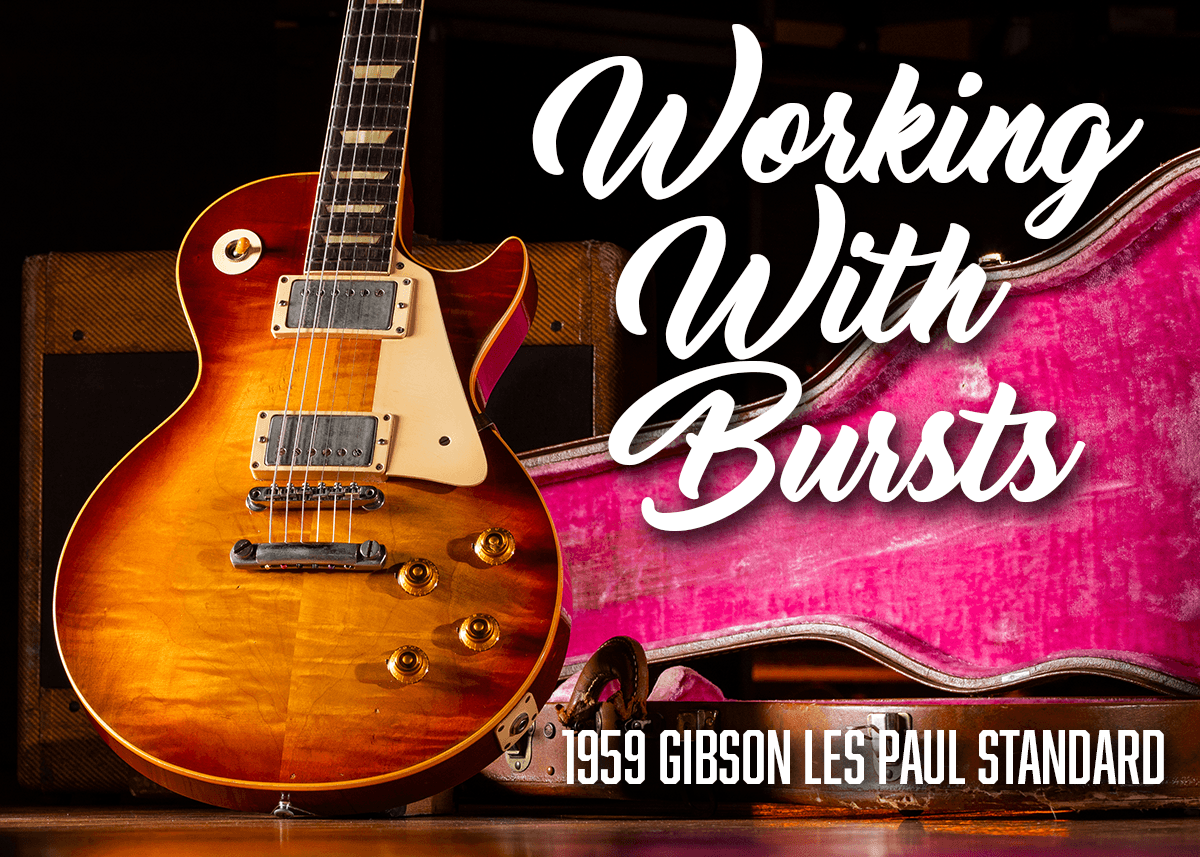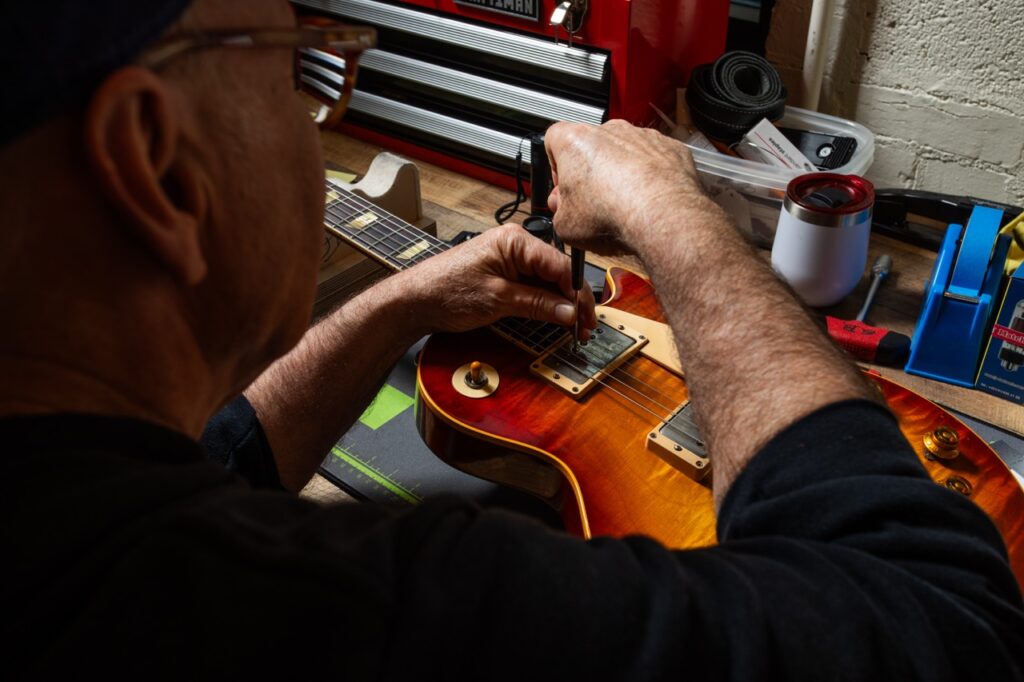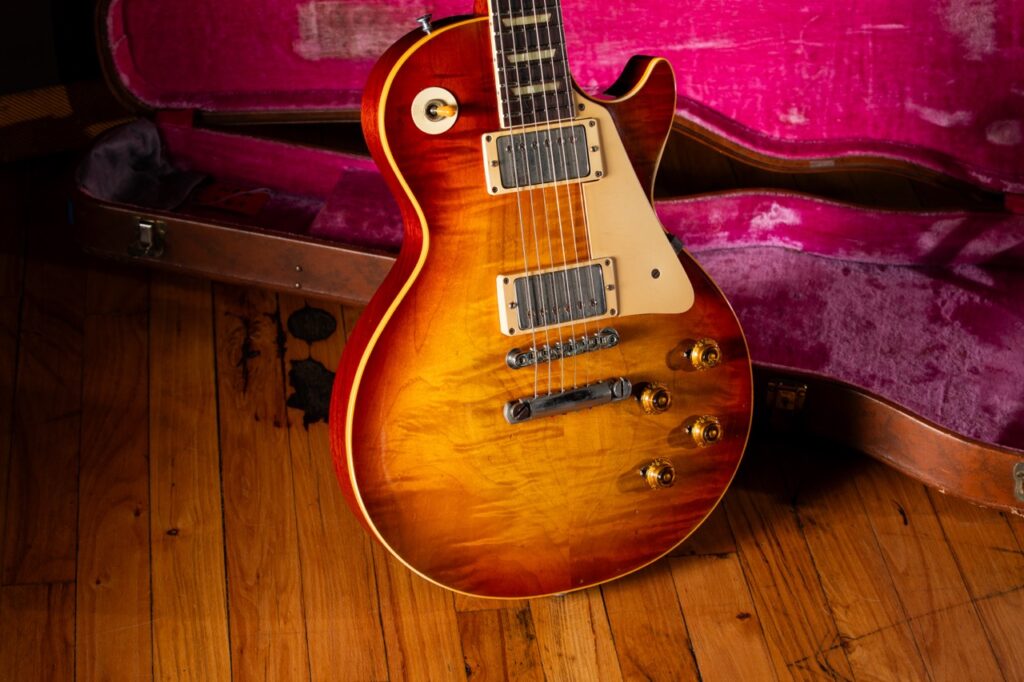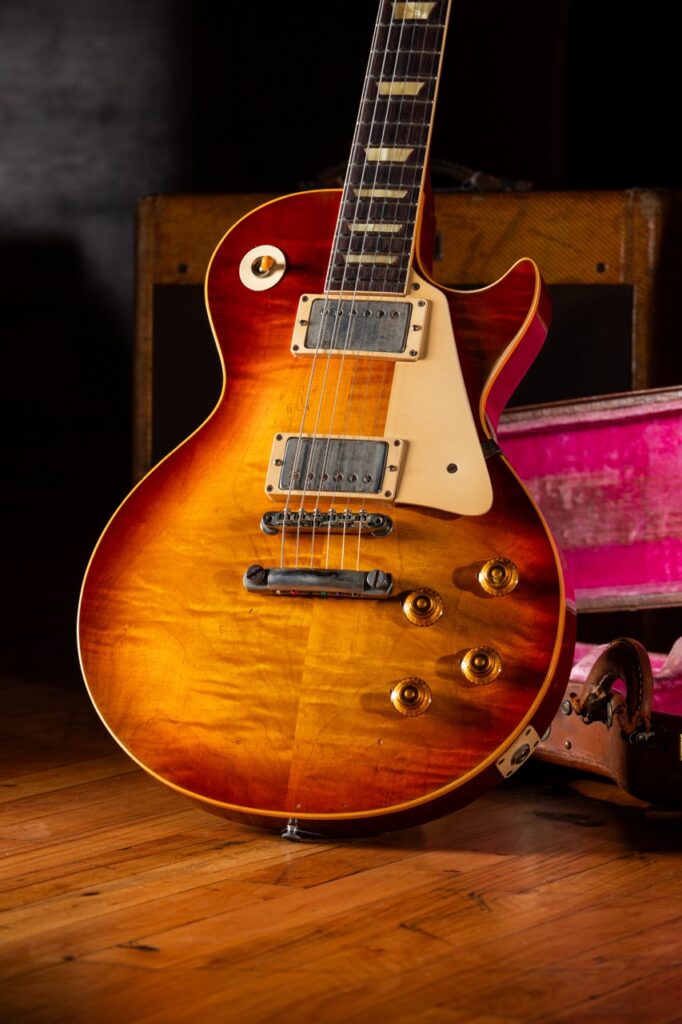
Working With Bursts
Yup, that’s my job. If there was a, “World’s coolest job” competition I would definitely submit my application. I love my job. It actually feels a little strange to call it a job. Sometimes, when a really cool guitar arrives at the store I end up losing sleep over it, or I’ll dream about that guitar. Almost every day that I’m at Carter Vintage closing time sneaks up and seriously interrupts my fun. Some days I’ll have things to do after work and I’ll need to leave asap. Usually though it’s, “Damn, I gotta go home” when closing time comes around. Now a lot of my attitude has to do with the crew that I work with. Simply put, this is the best group of people I’ve ever worked with. We all share a common mission, to make CVG the best guitar store on the planet. I’m proud to work here and I always sense that feeling from my teammates as well. We get along well and we help each other out as much as possible through the day, every day. I get phone calls from my friends at the store on my off days. I never ignore them or let them go to voicemail. I’m alway glad that someone wants my help and it’s a great feeling to help my coworkers solve any sort of problem that may arise.
Another part of what makes my job the world’s coolest job is the actual mechanics of it. I look at old guitars all day. That’s basically all I do. I look at the coolest collection of vintage guitars on the planet… every day. Take tomorrows project, or I should say, opportunity. Because examining a 1959 Gibson Les Paul Standard is exactly that: an opportunity. Someone asked me a while back if I ever felt jaded at my job? Honestly, I’ve never felt that way about authenticating old guitars. Each one is a new challenge and an opportunity to learn something or confirm what I know about an instrument. Plus, there’s so much to learn from a guitar. When you pick them up and play them it’s like having a conversation. Some guitars are great conversationists, they’re not shy and they speak right up. Some are a bit shy and you have to draw them out a bit to get them to speak up. Some of them have been locked away in cases for years and you have to coax them out of their slumber. And alas, some of them are sort of boring and after playing them for a little while, well, back in the case you go. Sorry I disturbed your slumber. Luckily, that’s a very rare case.
Tomorrow’s project, and I know I’m going to lose sleep about this, is to look at a “Burst.” An absolutely gorgeous burst at that. It’s serial number 9 1967. Before we get to the guitar, as a musical instrument, let’s talk a bit about the background of this Les Paul.

Some old guitars that come to our store have been played, and played hard. They’re far from mint condition. They have battle scars and wear. They have repairs, they have stories. Those are the most intriguing instruments for me. I see a guitar with a few repairs, some finish wear, a refret or two and it’s all part of the story the instrument’s trying to tell me. Someone played that guitar, they loved it and played it for a living. The guitar, and the owner, racked up a lot of mileage playing music and it’s fun for me to see that mileage on a guitar. It’s also a clue.
Have you ever picked up an old guitar with a lot of finish wear, some battle scars, maybe it has a repair or two, and noticed that there’s a reason for all that wear? It’s not always a sure thing but at least ninety times out of a hundred a guitar that’s been played, and played hard, is usually the one with the magic. I had a little archtop collection back in the day with some gorgeous Gibson L-5s. To me those guitars are the absolute height of craftsmanship and guitar building artistry. The guitars I had were crazy clean, all original and I thought they were great instruments to play and to listen to. Then I made friends with a guy who had an L-5 himself. He was a great guitar player and his L-5 didn’t look like any of mine. It certainly wasn’t mint. That thing was missing all the finish on the back of the neck. The back of the guitar was gouged and bruised here and there. The top had some scars to it, the headstock had a repaired crack and overall about half the finish had been played off the guitar. How did that guitar sound? It was alive! It made all of mine sound dead and lifeless. My friend schooled me about archtops. The more you play them, the better they sound. The more you can get the top to move on an archtop, the better the sound and the only way to get the top to move was to play it. It was an excellent lesson for me. Within a few months I sold my pretty guitars, found one that had been seriously played and had a sound like a concert grand piano. Lesson learned.
According to the guitars owner the guitar had been in a collection for years. There’s not much information about it out there.. One of my co-workers found a quick mention of the serial number on a forum post over twenty years ago. It almost qualifies as, “Uncirculated” save for that mention on the internet. It’s these kinds of instruments that I find to be endlessly intriguing.

Let’s take a closer look at 9 1967. Oh, first off, what should we call it? 1967 was known as The Summer of Love. There’s already a Summer’s burst, so we can’t do that. There is a lot to love with this guitar. It deserves a name. Ok, while we ponder names, let’s dive in.
The top. That’s where you start with a burst, the top. The 1900 series tops are, for the most part, totally insane and this one definitely doesn’t disappoint. What’s up with 1900 series tops? There’s an old saying, “A picture is worth a thousand words.” If you’re into sunburst Les Pauls may I suggest some books? Actually, let’s make this simple, one book is all you need to start with. The book is by Yasuhiko Iwanade and it’s called, “The Beauty of the Burst.” There’s a few 1900 series guitars in Yasuhiko’s book and they are all breathtaking. By the way, after you buy Mr. Iwanade’s book your next stop at the book shop should be all the books by Vic Dapra. I think there’s four volumes of Vic’s “Burst Believers” and they’re all a must have if you’re a Les Paul fan.
Ok, back to our burst. The top is just insane. I know I already said but it bears repeating. There’s something about the Eastern Maple that Gibson used around the time this guitar was made that’s so interesting to look at. When you move the guitar around in the light all sorts of different figure to the wood is revealed. In low, diffuse or non-direct light situations most bursts look almost like plain tops and 1967 is like that. That’s one of the fun things about bursts, they’re a bit like looking at diamonds. Sunburst tops, like diamonds, have facets that catch the light and reveal themselves, especially the 1900 series. It’s all endlessly fascinating to see in person.
The top, in the light, one this guitar reveals all sorts of crazy figure to the wood. It’s curly, it’s swirly, it’s just… a wild guitar to look at. One of my favorite aspects to the top on 1967 is the medullary grain to it. Medullary grain is the grain lines you see flowing all over the top on this guitar. For the most part, medullary grain is what you see running north and south on a sunburst top but not always strictly north and south. The “Figure” or “Flame” on a Les Paul sunburst top is the figure that runs east and west, from side to side. Depending on the way the wood is cut, the medullary grain can swirl around on the top and form all sorts of interesting patterns. Notice how the medullary grain on this guitar forms something that looks like a heart on the top of the guitar with the wide part right around the tailpiece. As you look further south the lines on each side begin to narrow until you reach to bottom of the guitar where they form a point.

If you take a closer look at the top it appears that the grain lines are kind of mirror images of each other in relation to each side of the guitar. This is called, “Book matching” the top. Not all sunbursts have book matched tops. It’s a bit of a longer subject to discuss and Yasuhiko has a chapter in his book about it. It’s an excellent discussion of how the people at Gibson chose tops and sometimes, but not all the time, book matched them.
Ok, we’ve discussed the top on 1967 fairly extensively but really, talking about a killer sunburst top is a bit like dancing about Monet. You can talk til you’re blue in the face but that doesn’t really do justice to the subject at hand. You have to look at the top to really get it. How about the rest of the guitar? Let’s discuss the neck, the pickups, playability and the way the guitar sounds.
The neck on 1967 is a classic 1959 carve. I call it the, “Mid-week’ carve. Not too big, not too small, no shoulders on the neck to speak of, and at the slightest most lovely taper from the nut up to where the neck meets the body. Early in the week carves tend to be a little thinner. Maybe the guy shaping the neck had a bit more energy after a nice weekend? Late in the week or, “Friday late afternoon near quitting time” necks tend to be big and nowhere near as nuanced as the neck on serial number 9 1967. 1959 Gibsons are renown for having the most perfect necks shapes. They just invite you to play the guitar. They’re easy to move around on and, for the most part, the size and shape of the neck on ‘59s just seem to be universally accepted as, “The” necks to play. Our guitar has new(er) jumbo frets and a new nut. So you end up with a combination of classic ’59 neck shape and a perfect refret. It’s like the best ever playing combination for a guitar. This thing plays like a dream. It’s effortless to play.
How does it sound? The pickups are PAFs, of course, and they both have zebra coils. Zebras are pretty rare, so that’s cool… and rare. A quick overview of early Gibson humbucking pickups: Les Pauls, and all other humbucker powered Gibsons, until mid ’59 always had double black coils in the pickups. Starting around the time this guitar was made they started to run out of black coils and the company that supplied them were shipping Gibson white coils. At first Gibson would pair a black coil with a white one and collectors coined the term, “Zebra coils” for these pickups. They’re rare, you don’t see too many zebra coil PAFs. A little later down the time line, by the last quarter of ’59 Gibson ran out of black coils entirely and both coils subsequently were white. Collectors call these, “Double white” coil PAFS, or “Double whites.”
The pickups in this guitar are also pretty hot. The neck pickup is 8.4K and the bridge clocks in at 9K. Pretty high numbers. What does that mean? Well, depending on the inductance of the each pickup it means that this thing was made to drive amplifiers into overdrive. Think of all your favorite sunburst Les Paul tones you’ve heard on record and know that 1967 is more than capable of getting you right there. All you need is a good amp, you’ll have to supply the talent.
How does it really sound? We’ll let Marcus tell you all about it.
This sunburst has some playing wear to it. Someone definitely loved playing this guitar and they played it a lot. There’s a significant amount of playing wear on the back of the neck. It also has a couple of battle scars. The corner of the headstock shows the the guitar took a hit there. The back of the neck, from the nut to around the 5th fret shows a very thin hairline crack. The bump on the headstock corner and the crack are probably related and happened at the same time. The crack was repaired with a little glue and the neck was oversprayed in that area. All this happened a very long time ago as the overspray is just about completely worn off the back of the neck. The crack has been examined by our repair staff and it’s completely stable. It doesn’t actually look like a crack at first glance, it looks like a long finish check or gouge.
All in all there’s a lot to love about this 1959 Les Paul at the store right now. It’s an iconic model guitar with all the right features that made them icons in the first place. If you’re in Nashville, and this guitar is still around, come down to the shop and check it out. It’s been a pleasure, and a privilege, to write about this instrument. Thank you for taking the time to read it.
Gary Bohannon
Carter Vintage Guitars
May 2025